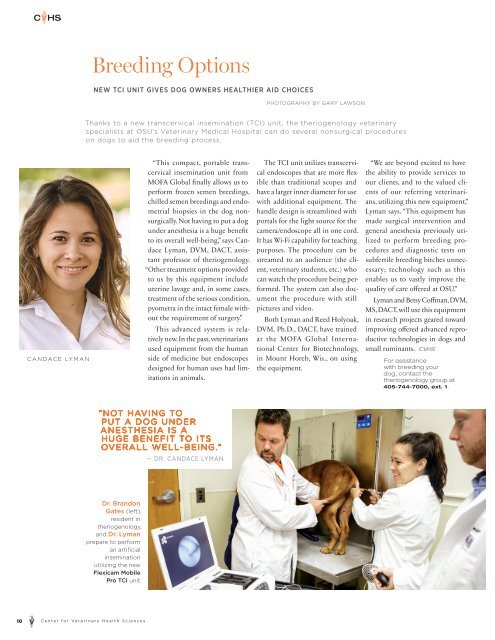Vet Cetera magazine 2015
Official magazine of the Center for Veterinary Health Sciences at Oklahoma State University
Official magazine of the Center for Veterinary Health Sciences at Oklahoma State University
Create successful ePaper yourself
Turn your PDF publications into a flip-book with our unique Google optimized e-Paper software.
Breeding Options<br />
NEW TCI UNIT GIVES DOG OWNERS HEALTHIER AID CHOICES<br />
PHOTOGRAPHY BY GARY LAWSON<br />
Thanks to a new transcervical insemination (TCI) unit, the theriogenology veterinary<br />
specialists at OSU’s <strong>Vet</strong>erinary Medical Hospital can do several nonsurgical procedures<br />
on dogs to aid the breeding process.<br />
CANDACE LYMAN<br />
“This compact, portable transcervical<br />
insemination unit from<br />
MOFA Global finally allows us to<br />
perform frozen semen breedings,<br />
chilled semen breedings and endometrial<br />
biopsies in the dog nonsurgically.<br />
Not having to put a dog<br />
under anesthesia is a huge benefit<br />
to its overall well-being,” says Candace<br />
Lyman, DVM, DACT, assistant<br />
professor of theriogenology.<br />
“Other treatment options provided<br />
to us by this equipment include<br />
uterine lavage and, in some cases,<br />
treatment of the serious condition,<br />
pyometra in the intact female without<br />
the requirement of surgery.”<br />
This advanced system is relatively<br />
new. In the past, veterinarians<br />
used equipment from the human<br />
side of medicine but endoscopes<br />
designed for human uses had limitations<br />
in animals.<br />
The TCI unit utilizes transcervical<br />
endoscopes that are more flexible<br />
than traditional scopes and<br />
have a larger inner diameter for use<br />
with additional equipment. The<br />
handle design is streamlined with<br />
portals for the light source for the<br />
camera/endoscope all in one cord.<br />
It has Wi-Fi capability for teaching<br />
purposes. The procedure can be<br />
streamed to an audience (the client,<br />
veterinary students, etc.) who<br />
can watch the procedure being performed.<br />
The system can also document<br />
the procedure with still<br />
pictures and video.<br />
Both Lyman and Reed Holyoak,<br />
DVM, Ph.D., DACT, have trained<br />
at the MOFA Global International<br />
Center for Biotechnology,<br />
in Mount Horeb, Wis., on using<br />
the equipment.<br />
“We are beyond excited to have<br />
the ability to provide services to<br />
our clients, and to the valued clients<br />
of our referring veterinarians,<br />
utilizing this new equipment,”<br />
Lyman says. “This equipment has<br />
made surgical intervention and<br />
general anesthesia previously utilized<br />
to perform breeding procedures<br />
and diagnostic tests on<br />
subfertile breeding bitches unnecessary;<br />
technology such as this<br />
enables us to vastly improve the<br />
quality of care offered at OSU.”<br />
Lyman and Betsy Coffman, DVM,<br />
MS, DACT, will use this equipment<br />
in research projects geared toward<br />
improving offered advanced reproductive<br />
technologies in dogs and<br />
small ruminants.<br />
For assistance<br />
with breeding your<br />
dog, contact the<br />
theriogenology group at<br />
405-744-7000, ext. 1.<br />
“NOT HAVING TO<br />
PUT A DOG UNDER<br />
ANESTHESIA IS A<br />
HUGE BENEFIT TO ITS<br />
OVERALL WELL-BEING.”<br />
— DR. CANDACE LYMAN<br />
Dr. Brandon<br />
Gates (left),<br />
resident in<br />
theriogenology,<br />
and Dr. Lyman<br />
prepare to perform<br />
an artificial<br />
insemination<br />
utilizing the new<br />
Flexicam Mobile<br />
Pro TCI unit.<br />
10 Center for <strong>Vet</strong>erinary Health Sciences


